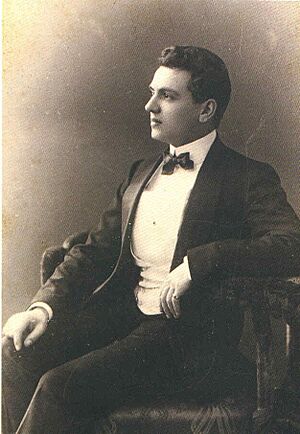Ernest Beaux facts for kids
Ernest Beaux (born December 7, 1881 – died June 9, 1961) was a famous French perfumer. He was born in Russia and is best known for creating Chanel No. 5, which is one of the most famous perfumes in the world.
Contents
Early Life and Family
Ernest Beaux was born in Moscow, Russia. His father, Edouard Hyppolite Beaux, was from Lille, France. Ernest's grandmother had moved to Russia in the 1840s.
Ernest's half-brother, Edouard Francois Beaux, also worked in the perfume business. He started as a clerk at Muir and Mirrielees in Moscow. Later, he joined a well-known Russian perfume company called A. Rallet & Co.. He eventually became an important leader in the company.
Starting a Career in Perfume
In 1898, Ernest finished his basic schooling. He then started training as a lab technician at Rallet, a leading Russian perfume house. Rallet was very big, with about 1500 employees and many products. It was sold to a French perfume company, Chiris, that same year.
After two years of military service in France, Ernest returned to Moscow in 1902. He began his perfume training at Rallet. He learned from the company's technical director, A. Lemercier. By 1907, he finished his training and became a senior perfumer. He was also chosen to be on the company's board of directors.
Creating Famous Scents
In 1912, Russia celebrated 100 years since the Battle of Borodino. This battle was a big moment in history. For this celebration, Ernest Beaux created a perfume called "Bouquet de Napoleon" for Rallet. It was a floral Eau de Cologne and became very popular.
The next year, 1913, was another important anniversary. It marked 300 years since the Romanov dynasty began ruling Russia. Ernest Beaux created another perfume called "Bouquet de Catherine." This perfume honored Catherine the Great. However, this scent was not as successful. This might have been because Catherine the Great was of German background. At that time, tensions were growing between Russia and Germany, which led to World War I.
War Service and New Beginnings
When World War I started in 1914, Ernest Beaux joined the French army. He served in the infantry and later as an intelligence officer. He was in the military until 1919. During this time, his perfume colleagues from Rallet moved to La Bocca, France, to continue working with Chiris.
After leaving the army, Ernest Beaux moved to Paris. He still kept in touch with the former Rallet employees in France.
In his personal life, Ernest Beaux married Iraïde de Schoenaich in 1912. They had a son named Edouard. During the Russian Civil War, Iraïde and their son escaped from Russia. Ernest later divorced Iraïde and took care of their son. He then married Yvonne Girodon and had a daughter named Madeleine.
Working with Coco Chanel
In 1920, Ernest Beaux met the famous fashion designer Coco Chanel. This meeting happened in Cannes with the help of Grand Duke Dmitri Pavlovich of Russia, who was a friend of Coco Chanel. Ernest showed her some of his perfumes.
Chanel chose one of his scents, which was bottle number 5, as a Christmas gift for her best customers. When Ernest asked her what she wanted to name the perfume, she said: "I always launch my collection on the 5th day of the 5th month, so the number 5 seems to bring me luck – therefore, I will name it 'Nº 5'".
At first, only 100 bottles of Chanel No. 5 were made. Chanel gave them away for free in 1921. But people loved the perfume so much that she decided to sell it officially in her shops in 1922. That year, she also launched another perfume from Beaux's collection, Chanel No. 22. However, Nº 5 was much more popular.
In 1922, Ernest Beaux left Chiris. But because Chanel Nº 5 was so successful, the owners of Galeries Lafayette bought the rights to it in 1924. They created a new company called Parfums Chanel and hired Ernest Beaux as their chief perfumer. He created many famous perfumes for them until he retired in 1954.
Later Life
Ernest Beaux passed away in his Paris apartment on June 9, 1961, at the age of 79. His funeral church was beautifully decorated with roses.
Selected Perfumes by Ernest Beaux
- 1913 – Bouquet de Napoleon, Rallet
- 1914 – Bouquet de Catherine, Rallet
- 1920 – Le Gardenia, Rallet
- 1921 – No. 5, Chanel
- 1924 – Cuir de Russie, Chanel
- 1925 – Gardénia, Chanel
- 1926 – No. 22, Chanel
- 1926 – Bois des Îles, Chanel
- 1929 – Soir de Paris, Bourjois
- 1936 – Kobako, Bourjois
- 1955 – Premier Muguet, Bourjois
Many of Ernest Beaux’s original perfumes are kept at the Osmothèque in Versailles, France. This is a special place where the public can learn about and experience these historical scents.



